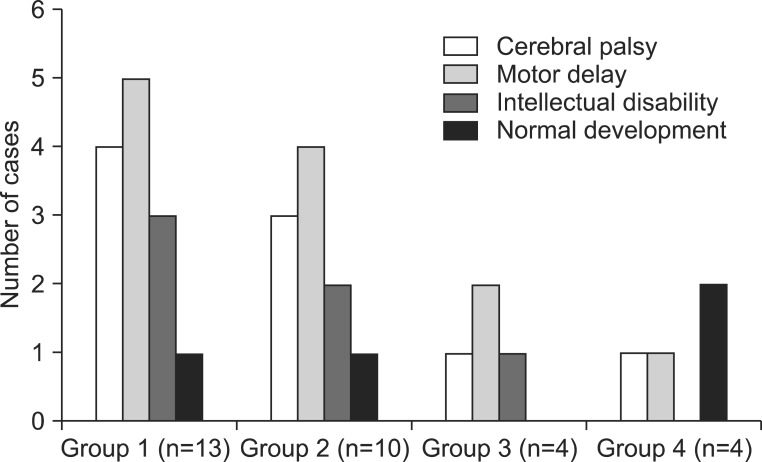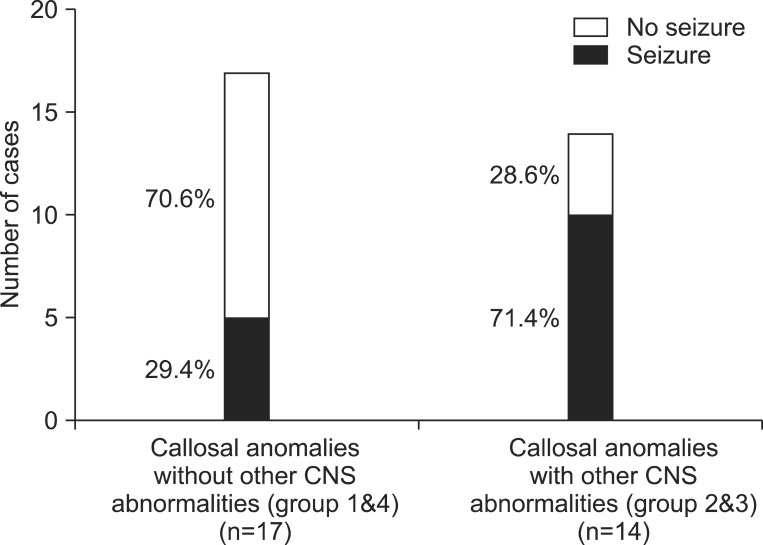Ann Rehabil Med.
2014 Feb;38(1):138-143. 10.5535/arm.2014.38.1.138.
Clinical Features and Associated Abnormalities in Children and Adolescents With Corpus Callosal Anomalies
- Affiliations
-
- 1Department of Rehabilitation Medicine and Research Institute of Rehabilitation Medicine, Yonsei University College of Medicine, Seoul, Korea. medicus@yuhs.ac
- KMID: 2266553
- DOI: http://doi.org/10.5535/arm.2014.38.1.138
Abstract
- Callosal anomalies are frequently associated with other central nervous system (CNS) and/or somatic anomalies. We retrospectively analyzed the clinical features of corpus callosal agenesis/hypoplasia accompanying other CNS and/or somatic anomalies. We reviewed the imaging and clinical information of patients who underwent brain magnetic resonance imaging in our hospital, between 2005 and 2012. Callosal anomalies were isolated in 13 patients, accompanied by other CNS anomalies in 10 patients, associated with only non-CNS somatic anomalies in four patients, and with both CNS and non-CNS abnormalities in four patients. Out of 31 patients, four developed normally, without impairments in motor or cognitive functions. Five of nine patients with cerebral palsy were accompanied by other CNS and/or somatic anomalies, and showed worse Gross Motor Function Classification System scores, compared with the other four patients with isolated callosal anomaly. In addition, patients with other CNS anomalies also had a higher seizure risk.
Keyword
MeSH Terms
Figure
Reference
-
1. Szabo N, Gergev G, Kobor J, Bereg E, Turi S, Sztriha L. Corpus callosum anomalies: birth prevalence and clinical spectrum in Hungary. Pediatr Neurol. 2011; 44:420–426. PMID: 21555052.2. Glass HC, Shaw GM, Ma C, Sherr EH. Agenesis of the corpus callosum in California 1983-2003: a population-based study. Am J Med Genet A. 2008; 146A:2495–2500. PMID: 18642362.
Article3. Boland E, Clayton-Smith J, Woo VG, McKee S, Manson FD, Medne L, et al. Mapping of deletion and translocation breakpoints in 1q44 implicates the serine/threonine kinase AKT3 in postnatal microcephaly and agenesis of the corpus callosum. Am J Hum Genet. 2007; 81:292–303. PMID: 17668379.
Article4. Marszał E, Jamroz E, Pilch J, Kluczewska E, Jabłecka-Deja H, Krawczyk R. Agenesis of corpus callosum: clinical description and etiology. J Child Neurol. 2000; 15:401–405. PMID: 10868784.
Article5. Kim GJ, Lee ES, Lee EJ, Han SS, Lee SH, Kim DH, et al. Prenatally diagnosed agenesis of corpus callosum. Korean J Obstet Gynecol. 2009; 52:1239–1244.6. Paul LK, Brown WS, Adolphs R, Tyszka JM, Richards LJ, Mukherjee P, et al. Agenesis of the corpus callosum: genetic, developmental and functional aspects of connectivity. Nat Rev Neurosci. 2007; 8:287–299. PMID: 17375041.
Article7. Mangione R, Fries N, Godard P, Capron C, Mirlesse V, Lacombe D, et al. Neurodevelopmental outcome following prenatal diagnosis of an isolated anomaly of the corpus callosum. Ultrasound Obstet Gynecol. 2011; 37:290–295. PMID: 21337654.
Article8. Tang PH, Bartha AI, Norton ME, Barkovich AJ, Sherr EH, Glenn OA. Agenesis of the corpus callosum: an MR imaging analysis of associated abnormalities in the fetus. AJNR Am J Neuroradiol. 2009; 30:257–263. PMID: 18988682.
Article
- Full Text Links
- Actions
-
Cited
- CITED
-
- Close
- Share
- Similar articles
-
- A Case of Agenesis of Corpus Callosum with Chromosome anomaly
- A Case of Acrocallosal Syndrome with Developmental Delay: A case report
- Measurement of Morphological Changes in Schizophrenic Patients using Brain Magnetic Resonance Imaging
- Agenesis of Corpus Callosum
- Measurement of Corpus Callosal Area in Schizophrenic Patients Using Magnetic Resonance Imaging




